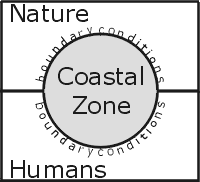Systems analysis
The subject of ICZM is the coastal zone. The coastal zone
is a complicated area where many physical (like people,
trees, water) and non physical items (organizations, laws)
exist and interact with each other. A good ICZM program
must be founded by a thorough comprehension of these items
and their relationships.
The coastal zone is a good example of an area where
interacting, complicated problems should be addressed
by means of systems analysis. Systems analysis
is a broad strategy to make an orderly and logical organization
of data into models. We will not present a complete
analysis of the coastal system, but the first steps
for such a study helps defining the subject: what are
its boundaries and what does it consist of?
As shown in adjacent figure, we can represent the world
as the box. The shaded circle represents the part we
are interested in: the coastal zone. At the highest
level of abstraction, the coastal zone is controlled
by two dynamic sources of activity: the nature - everything
else but human activities - provides the natural boundary
conditions, and the humans which provide "socio-economic
development plans": the more or less authoritative and
organized form in which the active human driving factor
comes to work.
|
A diagram of "our world"
The coastal system as a part of the world. The world consists
of the systems "Nature" and "Humans". Each of these two
provide the boundary conditions for the development of
the Coastal Zone.

|